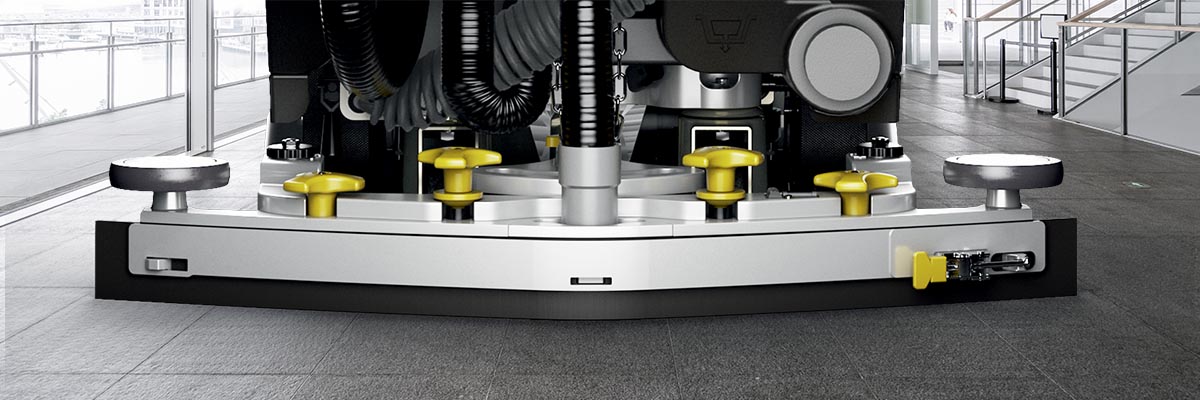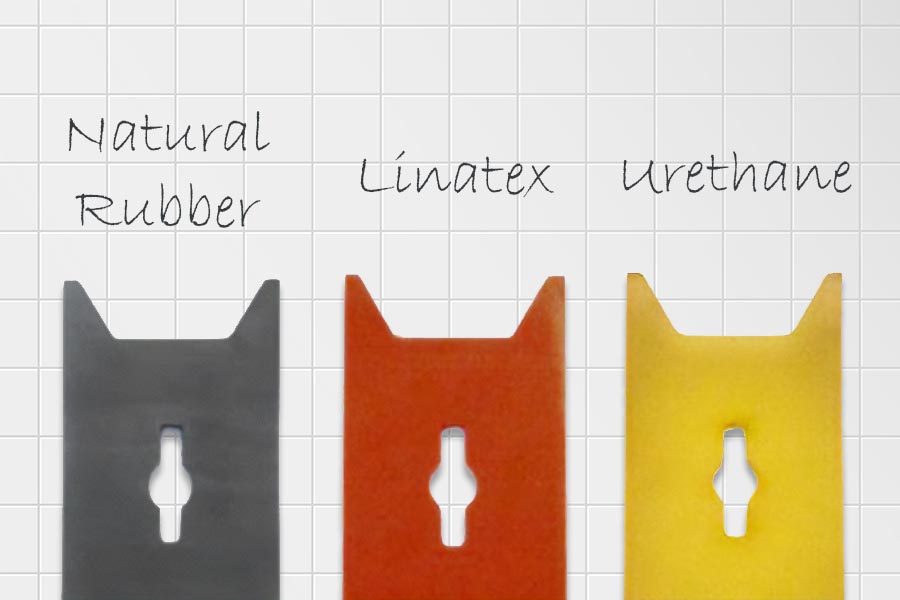A Complete Guide to Floor Scrubber Squeegee Blades
If you want spotless floors and an efficient cleaning process, maintaining your scrubber squeegee blades is key. Your blades are vital in removing water and debris from the floor, leaving them clean and dry.
In this article, we will explain the differences between different squeegee types and help you select the best option based on your floor type and soil.

Types of Floor Scrubber Squeegee Blades
There are three general categories for squeegee blades: natural rubber, Linatex rubber, and polyurethane. Each has its benefits and limitations, so choosing the right one for your situation will help your scrubber perform at its best.
Type 1: Natural Rubber
- Natural rubber squeegee blades are a common type of floor scrubber squeegee blade, widely used for general-purpose floor cleaning.
- Natural rubber blades are soft and flexible, providing excellent performance on smooth floors, like VCT, and floors with grout lines.
- The flexibility of natural rubber allows it to conform to the floor surface, ensuring efficient solution collection, especially in grout lines.
- Because of their softness, natural rubber blades tend to wear out more quickly than other types of squeegee blades.
- Natural rubber is not recommended for oily soils, which will quickly degrade the blade and give it a wavy appearance.
Type 2: Linatex Rubber
- Linatex Rubber is a type of floor scrubber squeegee blade with exceptional performance and durability. In addition to its tear-resistance and flexibility, Linatex Rubber is also highly durable, providing long-lasting performance. This can help reduce the need for frequent replacements, saving both time and money.
- Linatex Rubber is versatile and performs well on most floor types. Its high abrasion resistance makes it a good choice for rougher surfaces like concrete.
- Linatex Rubber offers better chemical resistance than natural rubber, but will still eventually be damaged by oily soils.
Type 3: Urethane Rubber Squeegee Blades
- Urethane squeegee blades are known for their excellent chemical resistance, making them ideal for use with a wide range of cleaning solutions.
- Urethane squeegee blades are recommended for oily soils. Recommended applications include kitchens, automotive repair shops, and machine shops.
- Urethane rubber performs well in wear tests and can be used on any floor surface.
- Urethane squeegee blades are generally more expensive than natural rubber blades, so they may not be the best choice if you don't need exceptional chemical resistance.

When to Change Squeegee Blades
Squeegee blades play a crucial role in the performance of floor scrubbing machines, ensuring efficient solution collection and streak-free cleaning. However, like any component, squeegee blades wear out over time and must be replaced to maintain optimal performance. Key indicators that can help determine when it is time to change your squeegee blades include:
- Reduced Cleaning Performance: One of the most apparent signs that squeegee blades need to be replaced is when you start noticing a decline in cleaning performance. If you notice streaks, puddles, or uneven water pick-up, it indicates that the squeegee blades are no longer effectively removing solution from the floor surface.
- Visible Damage: Inspect the squeegee blades regularly for any visible signs of damage, such as cracks, tears, or excessive wear. Even minor damage can compromise the effectiveness of the blades and may result in uneven cleaning or solution collection.
- Reduced Squeegee Flexibility: Over time, squeegee blades can lose their flexibility, resulting in decreased contact with the floor surface. If you notice that the blades are not conforming to uneven or textured surfaces as they once did, it's a sign that they need to be replaced.
When to Change Front Squeegee Blades
Specific indicators can help determine when to replace front squeegee blades. Here are some key points to consider:
- Blade Integrity: As long as the front squeegee blade is not torn and holds its shape, it can be flipped over and used on the other side. This can help extend the life of the blade and maximize its efficiency.
- Once both sides of the front squeegee blade have been used, it's time to invest in new squeegee blades.
When to Change Rear Squeegee Blades
There are a few signs that indicate when it's time to change the rear squeegee blades on an autoscrubber.
- Worn or Torn Blades: If you notice that the blades are torn or damaged, it is a clear indication that they need to be replaced. Any visible defect on the blade can create a streak during cleaning.
- Reduced Flexibility: Maintaining good contact between the squeegee blade and the floor surface is crucial for optimal performance. If the blade is stiff or brittle, it won't bend correctly and provide a good seal with the floor.
- Rotating the Blade: Rear blades usually have four edges that can be used for cleaning. To maximize their lifespan, it is recommended to rotate the blade as it wears down. Once all four edges have been used, it's time to replace the blade. This regular rotation helps to distribute wear evenly across the blade, prolonging its overall effectiveness.
Tips to Improve Squeegee Performance
- Dust Mopping: Before using a floor scrubber, it is essential to dust mop the area. This helps remove loose dirt and debris that could get caught beneath the squeegee blade and hinder its performance.
- Clean and Inspect the Squeegee Blade: Regularly checking the squeegee blade for cleanliness and tears is essential. Clean off any residue or build-up affecting its ability to make proper contact with the floor surface. SAFETY TIP: Wear hand protection or use a rag when wiping squeegee blades. Small, sharp debris can cut unprotected fingers.
- Check the Vacuum System for Air Leaks: A properly functioning vacuum system is crucial for effective liquid collection. Inspect the hoses, gaskets, and seals for any signs of air leaks. Addressing these issues promptly will ensure optimal suction and prevent streaking during cleaning.
- Ensure Squeegee Level and Proper Down Force: The squeegee blade should be level with the floor surface, and apply the right amount of force. Adjust the squeegee mechanism as needed to maintain proper alignment. Too much or too little pressure can affect the squeegee's ability to remove liquid efficiently.
- Consult the Operation Manual: Different floor scrubber models may have specific instructions for optimizing squeegee performance. Consult the operation manual for guidance on adjusting settings, maintaining proper blade alignment, and troubleshooting any issues.
By following these tips, you can improve the performance of your floor scrubber squeegee blades, ensuring efficient and streak-free cleaning.
Ask Hillyard for Help
If you need assistance with floor scrubber squeegee blades, Hillyard is here to help. Hillyard is a trusted and experienced provider of floor cleaning solutions, including squeegee parts for most floor cleaning machines. They offer expert guidance and support to help you find the right squeegee blade for your needs. Our dedicated team is committed to providing the support you need to keep your floors clean and your operations running smoothly.
You can contact Hillyard support by filling out the "I'm Interested" form at the bottom of this page. One of our representatives will contact you shortly.
Frequently Asked Questions
What is the best material for squeegee blades?
The optimal squeegee blade material depends on factors like floor type, chemicals used, and durability required. Common choices include natural rubber for general use, urethane for chemical resistance, Linatex for heavy-duty applications. Choose based on your specific cleaning needs and manufacturer recommendations.
How often should you replace a squeegee blade?
Squeegee blade replacement frequency varies based on usage and wear. As a general guideline, consider replacement every 3-6 months for moderate use. Heavy-use environments may require more frequent replacement, while light use might extend the lifespan. Regularly inspect the blade for cracks, tears, uneven edges, and reduced performance. Replace if signs of wear are evident to maintain effective cleaning results.
Why is my squeegee leaving streaks?
Streaks from a squeegee often result from improper technique, worn blades, or inadequate water pickup. Ensure the blade is in good condition and properly installed, as worn or damaged blades can't provide effective cleaning. Check the squeegee angle – it should have proper contact with the floor. Adjust water flow to provide sufficient moisture for smooth operation. Clean the squeegee assembly, vacuum system, and filters regularly. Experiment with adjustments to blade pressure, water flow, and machine speed to find the optimal settings for streak-free results.